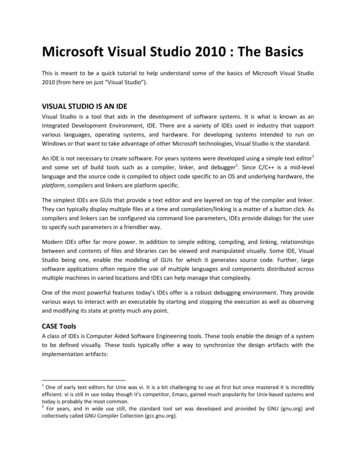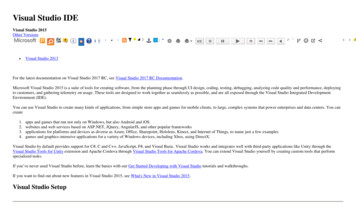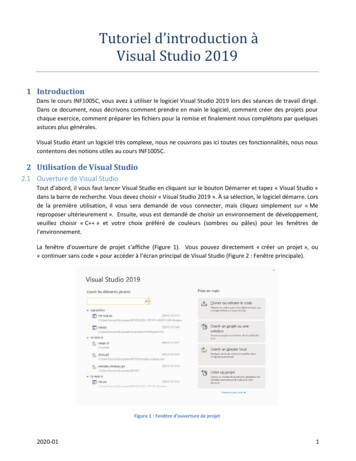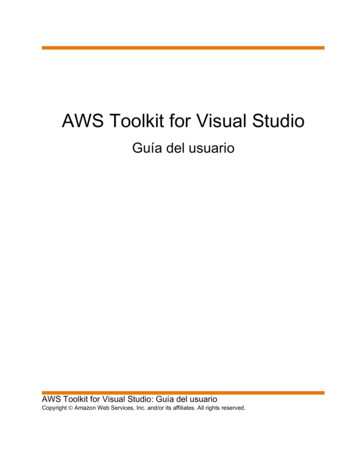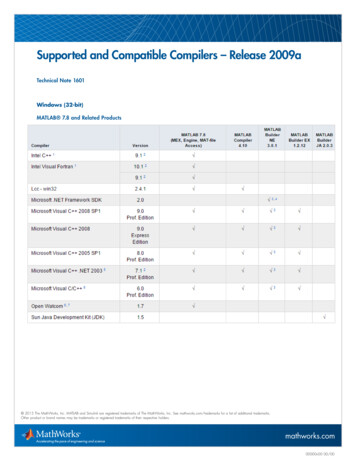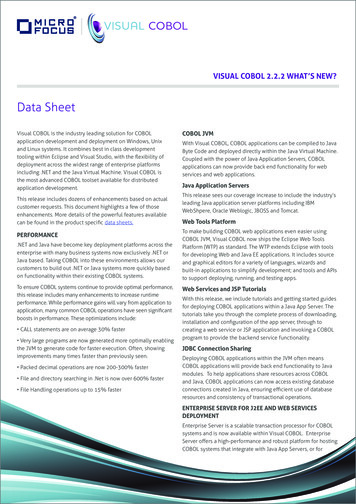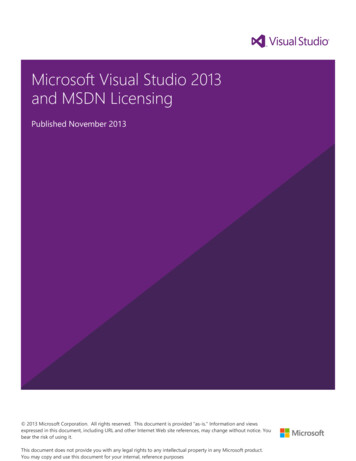
Transcription
Microsoft Visual Studio 2013and MSDN LicensingPublished November 2013 2013 Microsoft Corporation. All rights reserved. This document is provided "as-is." Information and viewsexpressed in this document, including URL and other Internet Web site references, may change without notice. Youbear the risk of using it.This document does not provide you with any legal rights to any intellectual property in any Microsoft product.You may copy and use this document for your internal, reference purposes
Table of ContentsMicrosoft Visual Studio 2013 and MSDN Licensing . 1Published November 2013 . 1. 1Introduction . 5Visual Studio 2013 Licensing Overview . 5Users . 5The Team Foundation Server Environment . 6Release Management Capabilities . 6Visual Studio Online . 6How to Buy. 7Visual Studio 2013 Offerings and Purchasing Channels . 7MSDN Subscription Renewals and Upgrades . 9Retail Renewals . 9Volume Licensing Renewals . 9MSDN Subscription Upgrade Options . 9Renewing Down . 10Visual Studio Online Purchasing . 10Other Channels . 10User Licensing. 12Licensed for Design, Development, Testing, and Demonstrating Your Programs 12What Software is Included and Downgrade Rights . 12Different Licensed Users Can Run the Same Software . 12Where the Software Can be Installed and Run . 13Additional Use Rights and Benefits for MSDN Subscribers . 13Production use of Office Professional Plus 2013 . 13Production Use of Visual Studio Team Foundation Server . 13Windows Azure MSDN Benefits . 13Visual Studio Online MSDN Benefits . 14MSDN Cloud Use Rights: Running the MSDN Software on Windows Azure VMs and VMs on Shared Servers Run by 3 rdParties . 14Lab Management . 152 2013 Microsoft Corporation. All rights reserved.
Storyboarding . 15Load Testing . 15SQL Server Parallel Data Warehouse Developer . 15IntelliTrace . 16When the Software Included is Subject to its Own Terms . 16Prerelease and Trial Software . 16SDKs, DDKs, Feature Packs, and patterns & practices Releases . 16Windows Embedded . 16IntelliTrace Collector and Microsoft Management Agent . 17Remote Tools . 17Scenarios in which Unlicensed Users can Use the Software . 17Demonstration Using Terminal Services . 17Acceptance Testing . 17Feedback . 17How Certain Software Can Be Distributed to Others within Your Applications18Other Guidance . 18When Windows on the “Developer Desktop” Requires a Separate License18When Virtual Environments Require a Separate License . 18Monitoring and Managing Development and Testing Environments Requires Management Licenses 19Perpetual Use Rights . 19Reassignment of the License . 20Distribution of the Software as Part of an Installation Image . 20Assigning MSDN Subscriptions to External Contractors . 20Product Keys and Installation Software . 21Using Software Sourced from MSDN but Licensed Under a Production LicenseSoftware Activation . 21Visual Studio Team Foundation Server 2013 Licensing . 21Obtaining Visual Studio Team Foundation Server 2013 . 22General Guidance for Licensing Team Foundation Server . 22Server Licensing Requirements for Team Foundation Server . 23Reassignment of the Server License . 23Using Visual Studio on the Build Server . 23Client Licensing Requirements for Team Foundation Server . 24When a Client Access License is Not Required . 243 2013 Microsoft Corporation. All rights reserved.21
Server Features Requiring More than a CAL . 24Choosing between User CALs and Device CALs . 25Multiplexing and Pooling Do Not Reduce the Need for CALs . 25Downgrade Rights for Team Foundation Server . 26Team Foundation Server under Software Assurance . 26Connecting Visual Studio Online to a Local Build Server . 26Methods of Accessing Team Foundation Server . 26Deployment Options . 27Multi-Server (Two-Tier) Deployment . 27Team Foundation Server Project Portal . 27Team Foundation Build Services . 28Lab Management Licensing . 28Lab Management Components . 28Lab Management Licensing . 29Visual Studio Release Management Licensing . 29Release Management Solution Components . 30Determining the number of Visual Studio Deployment licenses . 30Appendix . 31For More Information . 31Evaluating Visual Studio 2013 Products . 32Visual Studio Express 2013 Products . 32Licensing Training Environments . 32Historical MSDN Subscription Transitions . 32Visual Studio 2012 . 32Visual Studio 2010 . 33Visual Studio 2008 . 33Visual Studio 2005 . 34Licensing White Paper Change Log . 344 2013 Microsoft Corporation. All rights reserved.
IntroductionMicrosoft Visual Studio 2013 provides a comprehensive, highly flexible set of application lifecycle management (ALM)tools. Visual Studio 2013 provides enhancements within developer IDE making desktop, web, cloud, and Windows Storedevelopment more productive than ever. Team Foundation Server 2013 has added important new capabilities like AgileProject Portfolio Management, Team Rooms, Work Item Charts and Release Management that will help organizationsmanage agile teams and foster cross communications within teams. Visual Studio with MSDN offers customers high-valueMSDN benefits such as development/test use rights for Microsoft platform software like SQL Server/Windows/WindowsServer, monetary credits to use Azure resources, developer accounts on the Windows Store, Windows Phone Store and anO365 Developer subscription.The remainder of this paper provides an overview of the Visual Studio product line and the licensing requirements forthose products in common deployment scenarios. If you’re a volume licensing customer for a definitive guide to licensingterms and conditions, see the Microsoft Licensing Product Use Rights (PUR) and Product List, and the licensing programagreement. For retail customers the license terms are specified in the Retail Software License Terms included with yourproduct.Visual Studio 2013 Licensing OverviewWith the primary Visual Studio 2013 offerings there are essentially three things for which you purchase licenses:1. Users2. The Visual Studio Team Foundation Server environment3. Servers receiving automated deployments through Visual Studio Release Management capabilitiesAdditionally, there are Visual Studio Online services that you can purchase.UsersThe primary way to license users is by purchasing the appropriate level MSDN subscription for each user who will beparticipating in software development projects. The software, services, and support included with MSDN subscriptionsvaries by level, so you should consult the MSDN subscription comparison to determine the right level for the needs ofeach team member. The Visual Studio and other Microsoft software that the MSDN subscriber can install and run isdefined by what is available for that MSDN subscription level in MSDN Subscriber Downloads while the user’s subscriptionis active.MSDN subscription options: Visual Studio Ultimate with MSDN Visual Studio Premium with MSDN Visual Studio Test Professional with MSDN Visual Studio Professional with MSDN MSDN Platforms MSDN Operating SystemsAlternatively, for users who do not need to use any Microsoft platforms like Windows, Windows Server, SQL Server, etc. aspart of their development efforts, who do not need use of Windows Azure, who do not need technical support, who do5 2013 Microsoft Corporation. All rights reserved.
not need e-learning, who do not collaborate with other development team members via Team Foundation Server, andwho do not need access to new versions of the software, you can purchase a stand-alone Visual Studio Professionallicense.The Team Foundation Server EnvironmentThe Team Foundation Server environment is where the software developers, testers, project managers, stakeholders, andother participants in the software development team collaborate, manage source code, manage and prioritize work,generate builds of the application, and much more. You purchase Windows Server and Team Foundation Server licensesfor each server in this environment, plus Windows Server and Team Foundation Server Client Access Licenses (CALs) foreach user connecting to these servers. Microsoft SQL Server 2012 Standard is included with the Team Foundation Serverlicense for use with Team Foundation Server.Release Management CapabilitiesVisual Studio 2013 provides a continuous deployment solution to Microsoft’s ALM and DevOps solutions through ReleaseManagement capabilities, helping customers deliver applications faster, better and more efficiently. The ReleaseManagement continuous delivery solution will automate the development-to-production release process from VisualStudio Team Foundation Server, helping enable faster and simpler delivery of applications. Each node or endpoint towhich an application is being deployed to must have a Visual Studio Deployment license.Visual Studio OnlineVisual Studio Online offers a broad and growing set of cloud-based Application Lifecycle Management capabilities. WithVisual Studio Online, you purchase a plan or an MSDN subscription for each user accessing your Visual Studio Onlineaccount—based on the capabilities needed for that user—and you purchase shared resources for use by the accountoverall. With shared resources you pay for what you use, such as minutes of cloud build time or virtual user minutes ofcloud load testing.Since eligible MSDN subscribers can join a Visual Studio Online account at no additional charge, it is only the users whojoin an account who do not have MSDN subscriptions to whom a Visual Studio Online user plan needs to be assigned.There are three Visual Studio Online user plan options: 6Visual Studio Online AdvancedVisual Studio Online ProfessionalVisual Studio Online Basic 2013 Microsoft Corporation. All rights reserved.
How to BuyVisual Studio products are offered through a variety of sales channels as outlined below. Except for direct purchasesthrough the MSDN.com/buynow site or Microsoft Store, license purchase are made through a software reseller.Visual Studio 2013 Offerings and Purchasing ChannelsMSDN Offerings Retail ChannelMicrosoft Volume ubscription Select, SelectPlus Open Value,Open ValueSubscription Open Campus,Enrollmentfor EducationSolutions FullPackagedProduct(FPP) MicrosoftStore (onlineonly) MSDN.com/buynow(direct) 2013 Microsoft Corporation. All rights reserved.
Non MSDN Offerings PurchasingChannels Retail ChannelMicrosoft Volume LicensingEnterprise,EnterpriseSubscriptionSelect, SelectPlus Open Value,Open ValueSubscriptionOpen Campus,Enrollmentfor tStore (onlineonly) MSDN.com/buynow(direct) Each Microsoft Volume Licensing program has specific rules and benefits which your software reseller can help youunderstand so you can make the right choice. More information on Volume Licensing and the above programs can befound at: www.microsoft.com/licensing.8 2013 Microsoft Corporation. All rights reserved.
MSDN Subscription Renewals and UpgradesMSDN subscriptions that are due to expire can be renewed cost effectively. Renewal pricing is considerably lower thanpurchasing a new MSDN subscription because the customer only pays for the ongoing right to receive new versions of thesoftware, access to new product keys plus other expiring MSDN services, but not for a new license of the Visual Studiodevelopment tool, which the customer already has.Retail RenewalsRetail MSDN subscriptions must be renewed annually. The renewal grace period—that is, the period from when the MSDNsubscription expires to the point where the customer loses the option to renew at the renewal price—is 30 days for RetailLicenses.Volume Licensing RenewalsMSDN subscriptions purchased under most Volume Licensing programs are valid until the Volume License Agreement orEnrollment terminates. However, the Select Plus Agreement (which does not expire) is an exception. Purchases underSelect Plus last for 3 years from the date of purchase and there are also options for aligning the subscription term enddate with an Agreement anniversary date.For all Volume Licensing Programs, MSDN subscriptions must be renewed by purchasing the Software Assurance (SA)version of the product by the deadline specified under the Volume Licensing agreement. These deadlines vary byprogram, and may also vary depending on the terms in place when the agreement was signed.MSDN Subscription Upgrade OptionsYou can upgrade an active MSDN subscription either at renewal (in which case you must purchase both the subscriptionrenewal at the former level and a “step-up” license which upgrades the subscription) or at another point during the termof the subscription.Upgrade from:Microsoft VolumeLicensingUpgrade to:9Enterprise, Enterprise Subscription Select, Select Plus Open Value, Open Value Subscription 2013 Microsoft Corporation. All rights reserved.
Upgrades are not available in other programs, but retail and Open License customers (where Step-up Licenses are notavailable) can still take advantage of Step-up Licenses by renewing into the Open Value program and immediately buyinga Step-up.Renewing DownCustomers may “renew down” from a higher-level MSDN subscription to a lower-level MSDN subscription—effectivelytrading one license for another. In doing so, the customer forfeits all rights associated with the old MSDN subscription andmust immediately discontinue using any products that were available as part of that subscription but that are not availableunder the new subscription.Example: An organization has been using Visual Studio Premium with MSDN subscriptions across their developmentteam. The organization decides to renew all their subscriptions down to Visual Studio Professional with MSDN due tobudget constraints. When the organization renews down, subscribers must immediately discontinue using and uninstallVisual Studio Premium—and thus can no longer benefit from the features in Visual Studio Premium. Subscribers alsolose rights to use Microsoft Office, Microsoft Dynamics, SharePoint Server, and many other products included in VisualStudio Premium with MSDN but not in Visual Studio Professional with MSDN.Visual Studio Online PurchasingIn many cases, no purchase is necessary for using Visual Studio Online services. There is no extra charge for eligible MSDNsubscribers who join the account, and there are five free users with the Visual Studio Online Basic user plan per account.Additionally, there are free amounts of certain shared resources available per account.When Visual Studio Online user plans and shared resources need to be purchased, this is done through Windows Azure.The Windows Azure Management Portal enables customers to link an existing Visual Studio Online account or create anew one, after which it is possible to purchase Visual Studio Online services using the pre-paid funds or the paymentmethod set up within the Windows Azure subscription. Discounts are available depending on the size of Windows Azurespending commitment, and these discounts apply to all services purchased, including Visual Studio Online services.Other ChannelsCertain Visual Studio products are available for purchase through other Microsoft programs, including: Service Provider Licensing Agreement (SPLA): Visual Studio Team Foundation Server, Visual Studio Ultimate, VisualStudio Premium, Visual Studio Professional, and Visual Studio Test Professional are available on a subscriptionbasis through participating hosters. The hoster offers the software running on its own hardware that you connectto remotely. These are not MSDN subscription offerings. Use terms for the SPLA are covered in the ServicesProvider Use Rights (SPUR) document. Microsoft ISV Royalty Licensing Program for ISVs wishing to include Visual Studio or other Microsoft productswithin their finished software applications and distribute them to customers.Additionally, MSDN subscriptions or Visual Studio are provided as program benefits under certain Microsoft programs: 10Microsoft Partner Network: Partner MSDN subscribers may use the software in accordance with the MSDNsubscriptions not for resale (NFR) retail license terms. MSDN subscriptions offered as benefits of the MicrosoftPartner Network, including those provided through Microsoft Action Pack Development and Design, cannot beused for direct revenue-generating activities, such as providing consulting services, customizing a packaged 2013 Microsoft Corporation. All rights reserved.
application for a specific customer, or building a custom application for a customer, for a fee. Partners can useMSDN subscriptions for indirect revenue-generating activities, such as building a packaged application on theMicrosoft platform, which they can then market and sell to customers. Partners can also purchase MSDNsubscriptions separately for use in direct revenue-generating activities. Microsoft BizSpark: Microsoft BizSpark is a global program that helps software startups succeed by giving themaccess to Microsoft software development tools, connecting them with key industry players, including investors,and providing marketing visibility to help entrepreneurs starting a business. The Visual Studio Ultimate withMSDN subscriptions offered through BizSpark are subject to the MSDN subscriptions not for resale (NFR) retaillicense terms. Microsoft DreamSpark: provides tools to students, faculty, and staff at academic institutions for instructional use(e.g., for instruction, coursework, and non-commercial research) for a small charge per institution. Academicinstitutions participating in the Campus Agreement/EES and OVS/ES programs in Microsoft Volume Licensingreceive an online subscription to DreamSpark at no additional cost. The software licensed through DreamSparkincludes Visual Studio Professional, Windows Server, and SQL Server among other software. In addition, Science,Technology, Engineering, and Math (STEM) departments in higher education institutions may qualify for an onlineDreamSpark Premium subscription (formerly known as MSDN AA) which offers access to a wider range ofMicrosoft software titles. To take advantage of their DreamSpark subscription benefit (DreamSpark orDreamSpark Premium depending on eligibility), academic customers need to enroll on.aspx using their Academic Volume Licensing agreementnumber and the appropriate DreamSpark promotion code that are included in their Academic Volume Licensingsubscription Welcome Letter. Students at institutions that do not have a DreamSpark subscription can verify theirstudent status on the DreamSpark site for no-cost access to the Account.aspxPlease consult the terms for each program for specific MSDN subscription use right additions or exclusions.11 2013 Microsoft Corporation. All rights reserved.
User LicensingLicensed for Design, Development, Testing, and Demonstrating Your ProgramsAll MSDN subscriptions and Visual Studio Professional are licensed on a per-user basis. Each licensed user may install anduse the software on any number of devices to design, develop, test, and demonstrate their programs. MSDN subscriptionsalso allow the licensed user to evaluate the software and to simulate customer environments in order to diagnose issuesrelated to your programs. Each additional person who uses the software in this way must also have a license.What Software is Included and Downgrade RightsFor MSDN subscriptions, the software that is included is defined as any software that is available to the subscriber viaMSDN Subscriber Downloads while the user’s subscription is active, plus downgrade rights to prior versions of any of thatsoftware (for legacy software versions that are not available in MSDN Subscriber Downloads). MSDN subscriptions includeboth current version software plus many prior versions dating back over a decade, and often carry multiple differenteditions (Standard, Enterprise, Datacenter, etc.) of the same product to support a variety of software development andtesting scenarios. Plus, MSDN subscribers are regularly gaining access to new versions of the software as it is released.Anyone can visit MSDN Subscriber Downloads, search for a particular download, and then click on the details to see whatdate the download was published and what subscription levels have access to download it. It is not necessary to be asubscriber to review this, though it is necessary to be a subscriber in order to download. For a more general view of whatsoftware is included with each MSDN subscription, you can compare MSDN subscriptions.For Visual Studio Professional, the software included in the license is the current version of the software, Visual StudioProfessional 2013, plus downgrade rights to simultaneously run prior versions of Visual Studio Professional to which youmay otherwise have access.For purposes of this User Licensing section, we will refer to the software included with the license as “the software.”Different Licensed Users Can Run the Same SoftwareEach member of the development team that will use (install, configure, or access) the software must have his or her ownMSDN subscription. Two or more individuals may use the same software if each has an MSDN subscription.Example 1: A development team consists of 6 software developers, 1 architect/developer, and 3 testers. The team isbuilding an in-house Web-based accounting system, and wants to use the software to set up a test environment runningWindows Server 2012 and Microsoft SQL Server 2012. If all 10 team members will be accessing the development ortest environment then each will require an MSDN subscription. The minimum subscription levels including both of theseproducts are Visual Studio Professional with MSDN and Visual Studio Test Professional with MSDN.Example 2: An organization has two development teams—one based in Seattle and the other in Singapore. Because ofthe time difference, the two teams are never working at the same time. However, because MSDN subscription licensescannot be shared, each team member in each location must have his or her own MSDN subscription.Example 3: A systems engineer from the organization’s IT department is installing the software needed for adevelopment team—each member of which is licensed with an MSDN subscription—on centrally-managed hardware.12 2013 Microsoft Corporation. All rights reserved.
This systems engineer is not doing any software development or testing. Because a license is required for any use ofMicrosoft software (installing is a use of the software), they must either acquire production licenses for all software beingused in this environment or they must acquire an MSDN subscription for the systems engineer that includes thesoftware he or she is installing.Where the Software Can be Installed and RunThe licensed user can install and use the software on any number of devices. The software can be installed and used onyour devices at work, at home, at school, and even on devices at a customer’s office or on dedicated hardware hosted by a3rd party. Most MSDN software can also be run in Windows Azure VMs and on VMs hosted by Qualified MSDN CloudPartners. However, the software is otherwise not licensed for use in production environments.A production environment is defined as an environment that is accessed by end users of an application (such as anInternet Web site) and that is used for more than Acceptance Testing of that application or Feedback. Some scenarios thatconstitute production environments include: Environments that connect to a production database. Environments that support disaster-recovery or backup for a production environment. Environments that are used for production at least some of the time, such a server that is rotated into productionduring peak periods of activity.Example: A developer with an MSDN subscription uses MSDN software at work during the day, but occasionally needsto develop at home as well, using a different computer. Under the MSDN license, there is no difference between a PC atwork and a home PC; the home PC is just another device on which the developer is entitled use the MSDN software.However, the restrictions for the MSDN software running on the developer’s home PC remain the same as in the workenvironment: the MSDN software installed on the home PC must only be used for design, development and testingpurposes; and only other users with an appropriate MSDN subscription can use the software.Additional Use Rights and Benefits for MSDN SubscribersProduction use of Office Professional Plus 2013Office Professional Plus 2013 can be used by licensed users of Visual Studio Ultimate with MSDN and Visual StudioPremium with MSDN on one device for production use.Production Use of Visual Studio Team Foundation ServerVisual Studio Ultimate with MSDN, Visual Studio Premium with MSDN, Visual Studio Professional with MSDN, VisualStudio Test Professional with MSDN,
each team member. The Visual Studio and other Microsoft software that the MSDN subscriber can install and run is defined by what is available for that MSDN subscription level in MSDN Subscriber Downloads while the user's subscription is active. MSDN subscription options: Visual Studio Ultimate with MSDN Visual Studio Premium with MSDN


